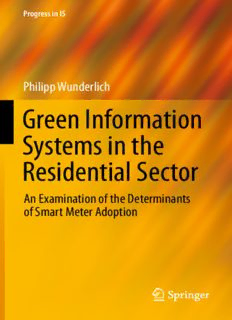
Green Information Systems in the Residential Sector: An Examination of the Determinants of Smart Meter Adoption PDF
Preview Green Information Systems in the Residential Sector: An Examination of the Determinants of Smart Meter Adoption
Progress in IS Philipp Wunderlich Green Information Systems in the Residential Sector An Examination of the Determinants of Smart Meter Adoption Progress in IS For furthervolumes: http://www.springer.com/series/10440 . Philipp Wunderlich Green Information Systems in the Residential Sector An Examination of the Determinants of Smart Meter Adoption PhilippWunderlich MannheimBusinessSchool UniversityofMannheim Mannheim,Germany ISBN978-3-642-36768-7 ISBN978-3-642-36769-4(eBook) DOI10.1007/978-3-642-36769-4 SpringerHeidelbergNewYorkDordrechtLondon LibraryofCongressControlNumber:2013935607 ©Springer-VerlagBerlinHeidelberg2013 Thisworkissubjecttocopyright.AllrightsarereservedbythePublisher,whetherthewholeorpartof the material is concerned, specifically the rights of translation, reprinting, reuse of illustrations, recitation,broadcasting,reproductiononmicrofilmsorinanyotherphysicalway,andtransmissionor informationstorageandretrieval,electronicadaptation,computersoftware,orbysimilarordissimilar methodologynowknownorhereafterdeveloped.Exemptedfromthislegalreservationarebriefexcerpts inconnectionwithreviewsorscholarlyanalysisormaterialsuppliedspecificallyforthepurposeofbeing enteredandexecutedonacomputersystem,forexclusiveusebythepurchaserofthework.Duplication ofthispublicationorpartsthereofispermittedonlyundertheprovisionsoftheCopyrightLawofthe Publisher’s location, in its current version, and permission for use must always be obtained from Springer.PermissionsforusemaybeobtainedthroughRightsLinkattheCopyrightClearanceCenter. ViolationsareliabletoprosecutionundertherespectiveCopyrightLaw. The use of general descriptive names, registered names, trademarks, service marks, etc. in this publicationdoesnotimply,evenintheabsenceofaspecificstatement,thatsuchnamesareexempt fromtherelevantprotectivelawsandregulationsandthereforefreeforgeneraluse. While the advice and information in this book are believed to be true and accurate at the date of publication,neithertheauthorsnortheeditorsnorthepublishercanacceptanylegalresponsibilityfor anyerrorsoromissionsthatmaybemade.Thepublishermakesnowarranty,expressorimplied,with respecttothematerialcontainedherein. Printedonacid-freepaper SpringerispartofSpringerScience+BusinessMedia(www.springer.com) To Charlotte and Anneliese . Foreword Electricity is becoming a more and more scarce and hence costly resource. In the yearsahead,manychallengeshavetobeaddressedinordertoprovideaseamless and sustainable supply of electric energy both in households (B2C) as well as industry(B2B).Oneofthefundamentalproblemsinthisdomainisthetransmission line capacity in the far-distance energy delivery as well as in the mid-range and regional distribution networks. Another massive impact in the current situation in many countries is the drastic increase of renewable energy in the energy mix and the decrease of other energy production forms, such as from nuclear or conven- tional power plants. The decision of a phaseout of nuclear power in Germany by 2020 is the most significant step in this direction. Other countries follow with similar examples. Today, most governments have realized that renewable energy sourcesmustplayamorepivotalroleintheenergymix.Thiscomesalongwitha numberofconcerns,oneofthemajoronesofwhichisthevolatilityassociatedwith theproductionofrenewableenergies.Ifwindblows,newlyinstalledoffshorewind parksproducehighamountsofelectricitywhichthenhavetobetransportedtothe pointofconsumption.Ifthesunshines,photovoltaicparksproduceasteadyenergy supply.However,ifthesundoesnotshineandthewinddoesnotblow,alternative electricity supplies have to be provided or, alternatively, the demand has to be reduced.Thereasonisthattheelectricityconsumedfromthenetworkhastomatch theelectricitysuppliedtothenetworkatalltimes.Inthecaseofamismatchofthese twoparameters,apoweroutageresults. Another major factor in consumption shift is the expected growth in electric mobility(e-mobility).Electriccarsrunonabattery.Thisbatteryhastoberecharged atnight.Assumingasharponsetintheadoptionofelectricmobilitybyusersinthe privatesegmentinnearfuture,loadprofilesmassivelychangeandmovetowardsa higherdemandintheresidentialsectorintheeveningsandafterworkhours.Hence, theincreasedshiftfromtraditionaltorenewableelectricityproduction,e-mobility, and the resulting shifts in production and consumption patterns have led to new concernsintheelectricitymarket.Onesolutiontothisisthe“conceptualizationof smartgrids,”whichisunderwayinmanycountries.Thisservesasanumbrellaterm for a number of different processes. In essence, it stands for the enrichment of vii viii Foreword electricity networks with information and communication technologies (ICT) in ordertodecreaseconsumptionaswellasincreaseflexibilityinproduction. Onthedemandside,so-calledsmartmeters,or“smartmetertechnology”(SMT), are one of the cornerstones of innovation. A smart meter replaces a traditional electricitymeter,whichhasonlythefeatureofmeasuringtheconsumedelectricity. SmartmetersareICT-enableddeviceswhichtrackalargenumberofinformation, e.g.,detailsofconsumptionpatternsovertime.Smartmetersalsoenableadynamic pricingintheelectricitysector,wheresofaronlyone(fixedpriceperkilowatthour) oramaximumoftwopricelevels(dayandnightsupply)haveexisted.Furthermore, smartmetersenablethecustomertochoosetoswitchtheconsumptiontooff-peak timesandtherebysavemoneysincetheelectricitypricewillbelower.Thisiseven possible to be automated, since devices (e.g., freezers or fridges, dishwashers, washing machines, or dryers in private households as well as industrial coolers andhigh-energy-consumingmachines)canbeenabledtobedirectlysteeredbythe energypriceoreventheenergysupplierinordertosmoothenthedemandcurve. All these new possibilities bear a lot of issues to be dealt with before they can takeeffect.Firstandforemost,thesmartmetertechnologyhastobeadoptedbya remarkablepercentageofendcustomersinordertoenabletheenergyprovidersto make use of its many different application possibilities. Regarding the issue of acceptance,severalaspectshavetobeconsidered.Amongothers,thisconcernsdata privacy,changeofbehavioralpatterns(i.e.,takingnoticeoftheenergypricebefore consuming),costandbenefitcalculationsofthemeteradoption,andmanymore. Theresearchfieldwhichiscurrentlyformingandwhichisstillinitsinfancyis thefieldofgreeninformationsystems(greenIS). In his work, Mr. Wunderlich addresses this field by investigating the deter- minants of smart meter adoption in the residential sector. His focus is to find out whichfactorsinfluencetheadoptionandcontinuedusagedecisionofindividualsin privatehouseholdsregardingsmartmeters.Withhiswork,Mr.Wunderlichmakesa significantcontributiontoresearchinthisratherunderdevelopedfield.Whileinthe past,manyresearchershavefocusedonthetechnicalaspectsofhowtoimplement, optimize, and integrate renewable energies, smart grids, and smart meters, the behavioral side has been neglected at large. However, if today’s societies would like to make smart meters a success, behavioral research is playing a key role in understandingmotivationsandhenceconsumptiondecisionsofprivatepersonsand alsobusinesses.Hence,theworkofMr.Wunderlichcontributestotheorybuilding intheinformationsystemswithrespecttogreeninformationsystemsadoptionand usage decisions. Furthermore, it is a valuable source of insights for practitioners whoaredealingwiththeEnergiewendeanditsimplications. This book is a very important contribution to the green information systems research,andIwouldliketowishthisbook,itsauthor,andallitsreadersthebest success. Mannheim ProfessorDr.DanielJ.Veit December2012 Acknowledgments This book is a result of my work as a doctoral candidate at the Dieter Schwarz EndowedChairofBusinessAdministration, E-BusinessandE-Governmentat the University of Mannheim and would not have been possible without the generous helpandsupportofnumerouspeople. First, I would like to express my heartfelt gratitude to my academic teacher andadvisorProf.Dr.DanielVeitforbeingaforward-lookingandreliablecaptain inmyjourneyofpursuingadoctoraldegree.Hesubstantiallysupportedandguided this journey through his steady encouragement, constructive feedback, and great opennesstonewideas.IamalsoindebtedtoProf.SaoneeSarkerforhersupportand guidance and the warm welcome at the Department of Management, Information Systems, and Entrepreneurship of the College of Business at Washington State UniversityinPullman. Second, I want to thank my colleagues at EnBW Regional AG. I owe my gratitude to Tanja Birk, Julia Erlich, Andreas Ha¨ndle, Dr. Franz Heilemann, RalphHermann,PhilippReichle,SvenVogel,andOliverStumppfortheirsupport and belief in my work. They made my time at EnBW Regional AG an enjoyable andpleasurableone. Further, I would like to express my gratitude to all of my colleagues at the UniversityofMannheim andatWashington State University.Iwanttoespecially thankEvaPeslova,DennisSteininger,ManuelTrenz,andJanHuntgeburthfortheir insightful discussions and great companionship throughout the last years. I also want to thank Xiao Xiao, Nathan Johnson, and Christopher Califf for making me feel at home during my stay in Pullman. I thank my colleagues Sabine Koch, Sabrina Hauff, Dr. Sabine Stollhoff, Dr. Martin Barth, Philipp Klo¨cker, and Thimo Schulze. They generously shared their time and experience with me andmademytimeattheUniversityofMannheimanenjoyableandunforgettable one. I would also like to express my gratitude to Prof. Dr. Johann Kranz and Prof.Dr.DirkTotzek.Ideeplyenjoyedthecooperativeandinsightfulworkduring thelastyear. Finally, I would like to express my heartfelt gratitude to my family and espe- ciallytomyparentsandsisterfortheirloveandsupportthroughoutmywholelife. ix
Description: